1lumen selects and reviews products personally. We may earn affiliate commissions through our links, which help support our testing.
Speras P4 review
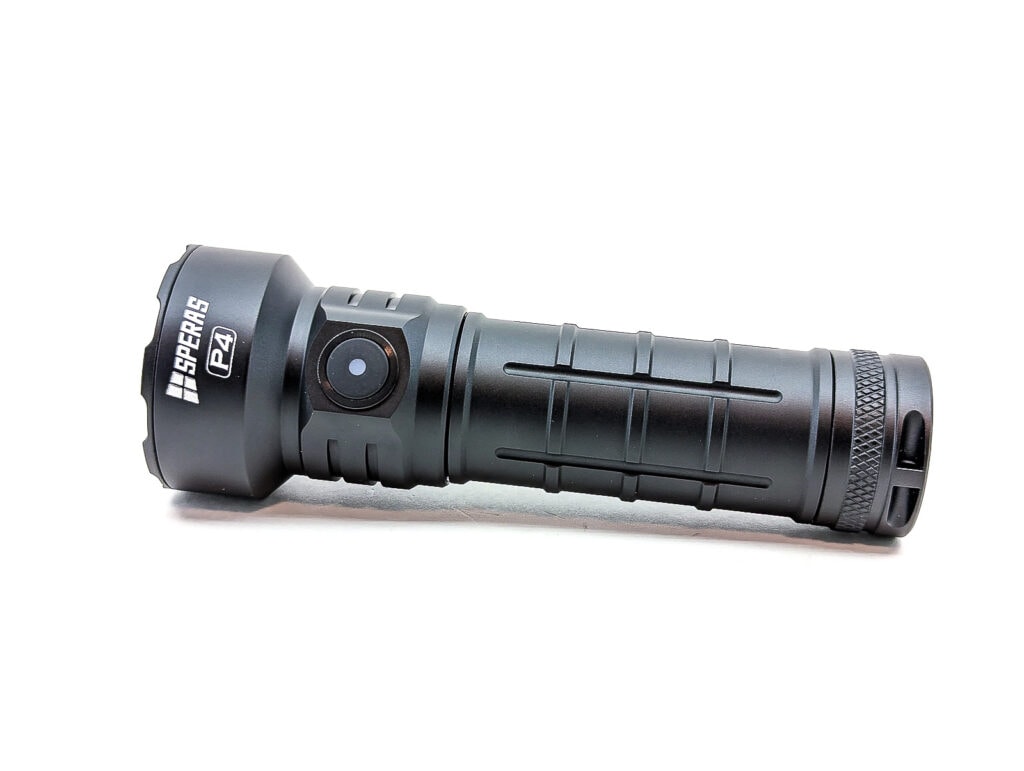
Speras P4 specs
| Brand & Model | Speras P4 |
|---|---|
| Flashlight category | EDC / searchlight / hunting |
| LED | OSRAM P9 x3 |
| Max. output | 4,000 lumens |
| Max. beam distance | 288 meters |
| Max. beam intensity | 20,750 cd |
| Battery config. | 1x 21700 |
| Onboard charging | USB-C |
| Modes | 5 |
| Blinkies | Strobe, SOS |
| Waterproof | IP68 |
| Review publication date | March 2023 |
Review intro:
I’ve reviewed a couple of Speras lights lately. My thoughts? In general, this fairly quiet brand has really impressed me with their overall quality and electronics / UI design. The M2R-35 headlamp and M4 pocket thrower were immediate successes in my mind. The flashlight we’re reviewing now – the Speras P4 – is a bit different than those. It’s certainly larger and is more of a large EDC flashlight / searchlight / outdoor kind of light. With a reasonably compact design (for a 21700 light) and boasting 4,000 lumens, it sounds good on paper. And initial impressions say that it should live up to the Speras name. But how does it perform?
Package quality.
The packaging for the Speras P4 is neither impressive nor disappointing. I’ve seen my share of brown cardboard boxes, and this is certainly a step up. That said, the Speras came in a pretty ordinary-looking white box with a hanger for display racks. The box itself is almost entirely white with just the name, an image of the P4, and a couple of key specs on the front. The back has a little chart and a description. Basic and to the point. Inside the box is a little plastic tray with the contents:
- Speras P4
- Battery (in the flashlight)
- USB charging cable
- USB-A to USB-C adapter
- Spare o-rings
- Holster
- Lanyard
- Manual
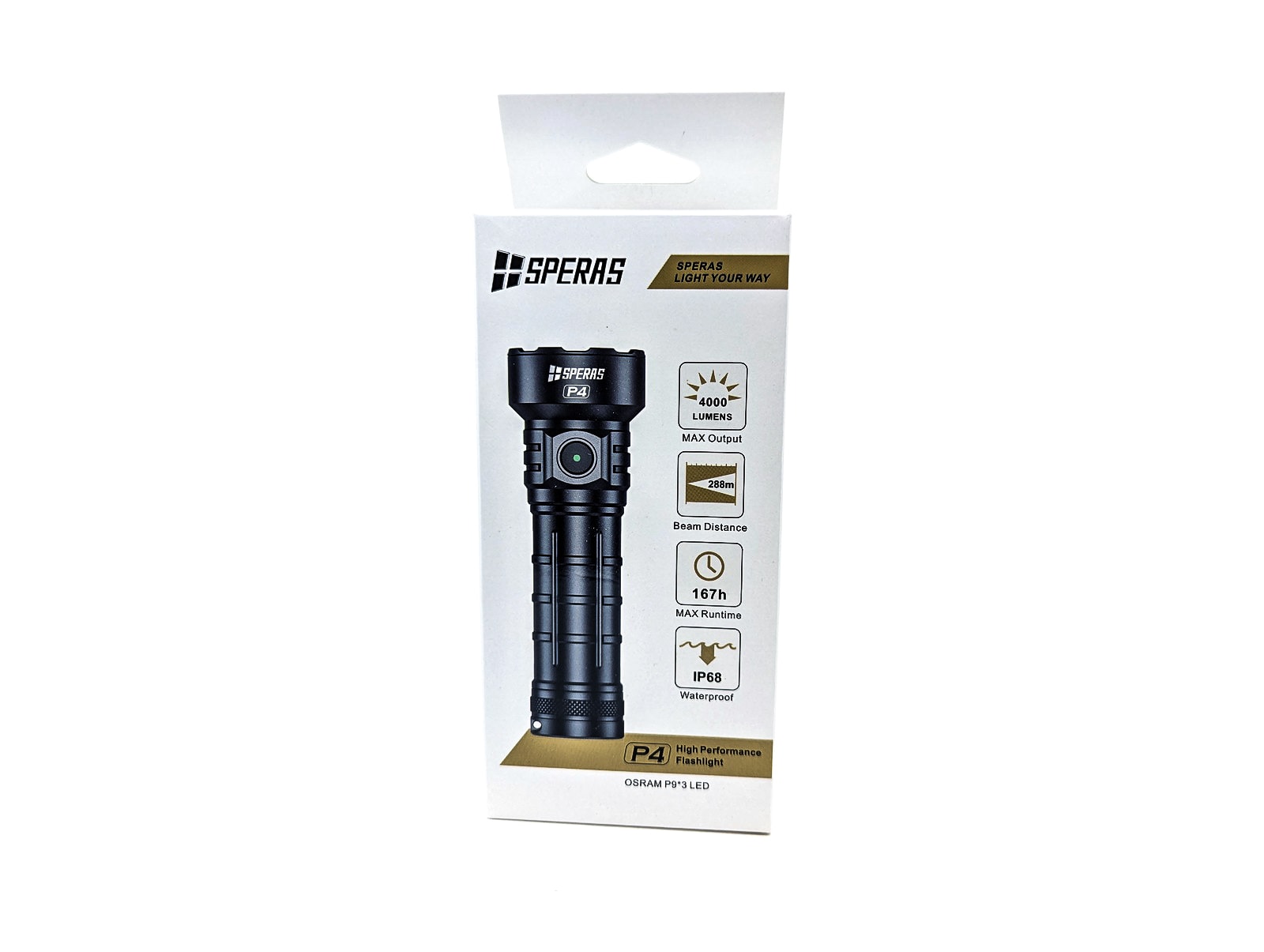
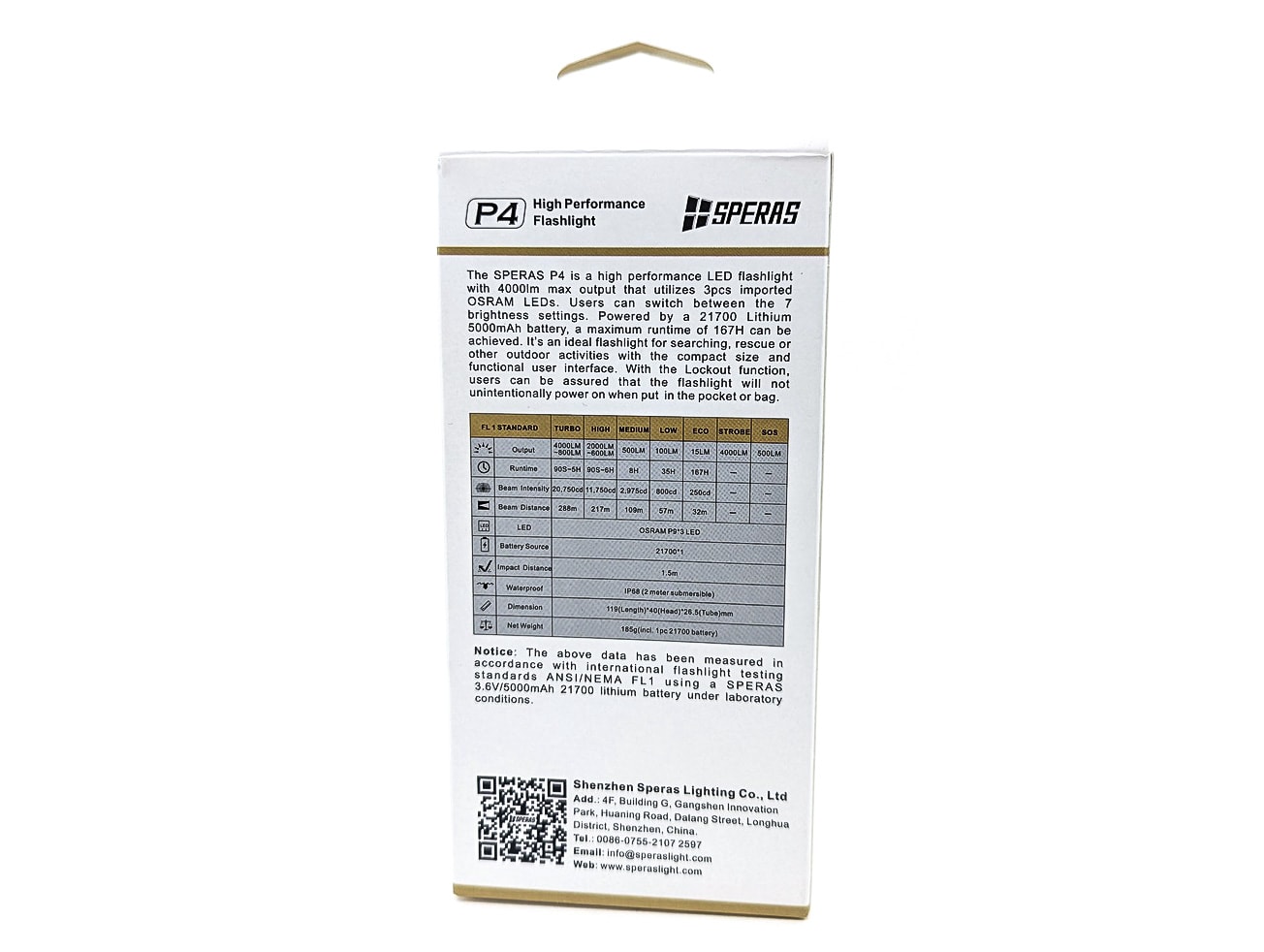
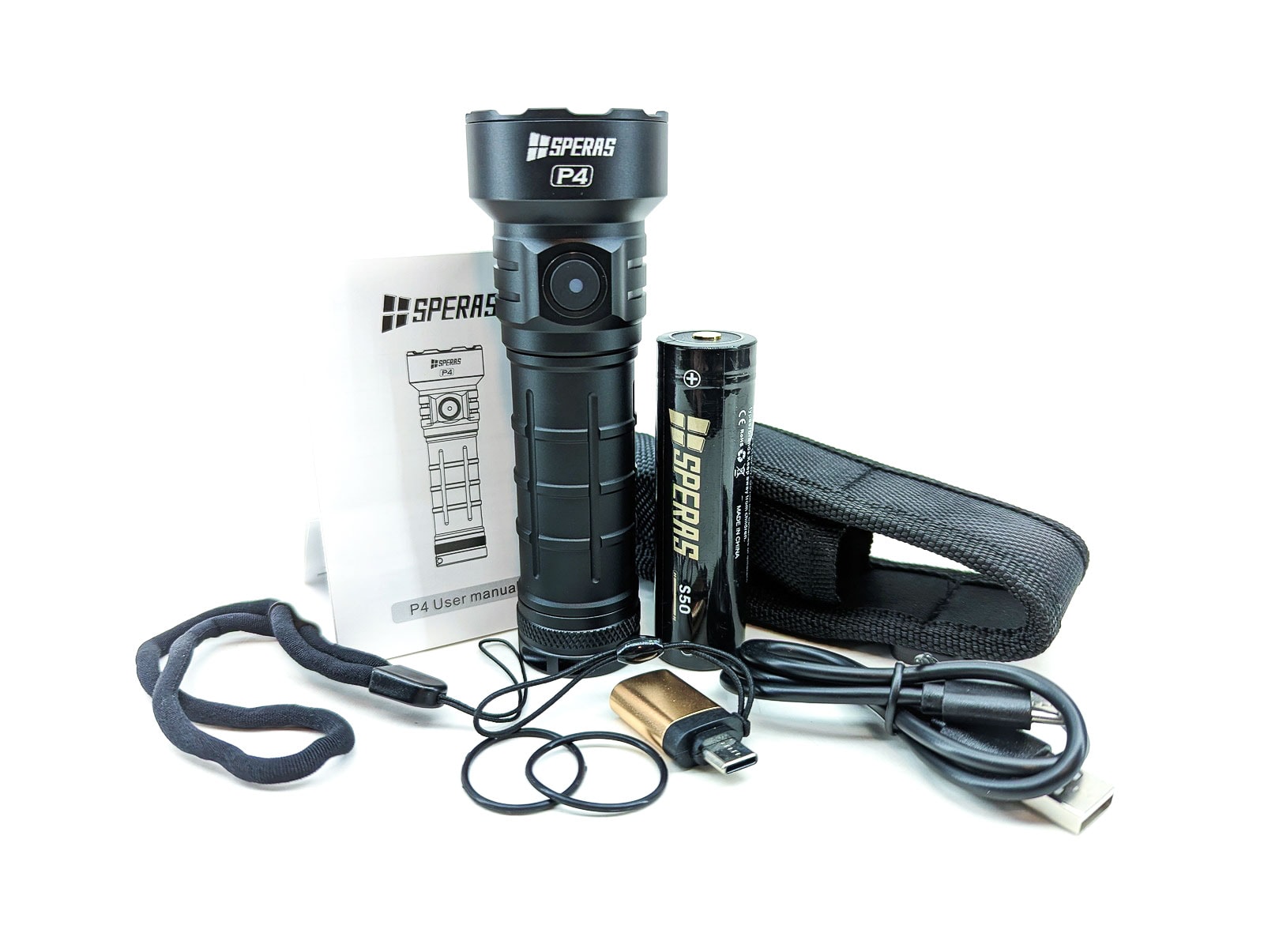
Flashlight in use
For a high-lumen, multi-emitter, 21700-based flashlight, the Speras P4 feels fairly compact. The battery tube is trim and comfortable to hold onto. The lone e-switch button is positioned on the side of the P4’s head. It has a shallow, clean press with good tactile feedback. Opposite the button is a USB-C port hidden behind a shallow rubber cover.
The body of the Speras P4 is very round and would roll off a flat surface if you’re not careful. The tailcap is very flat and perfect for tailstanding. There is no pocket clip, but the shape of the flashlight doesn’t lend itself much to using a clip. There is a bog-standard lanyard included, though, in addition to a nice holster. The holster has a hook & loop closer and seems well-built.
What would you use the Speras P4 for? Well, it’s a little large for a typical EDC light. It wouldn’t be very comfortable in your pants pocket for many hours, but it would sit nicely in a jacket pocket or riding shotgun in the included holster. The P4 would also make a good truck light or a by-the-door light for going on walks, around the house, looking for a lost dog, or perhaps tracking a wounded animal. It has a convenient size with lots of output and seems pretty flexible.
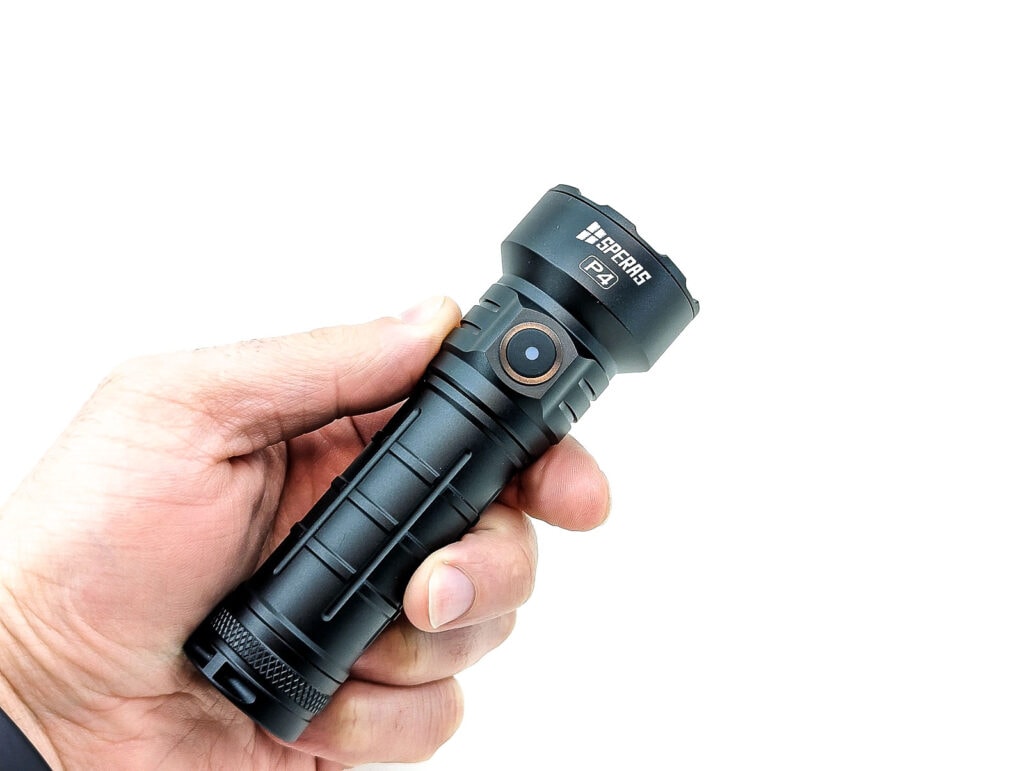
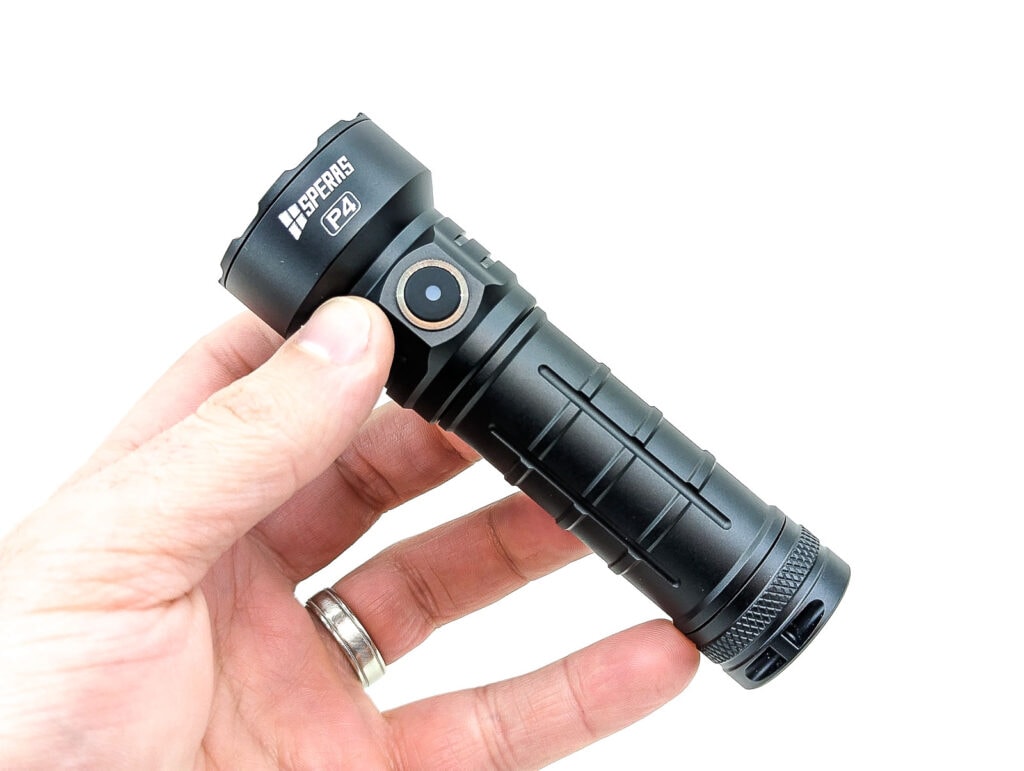
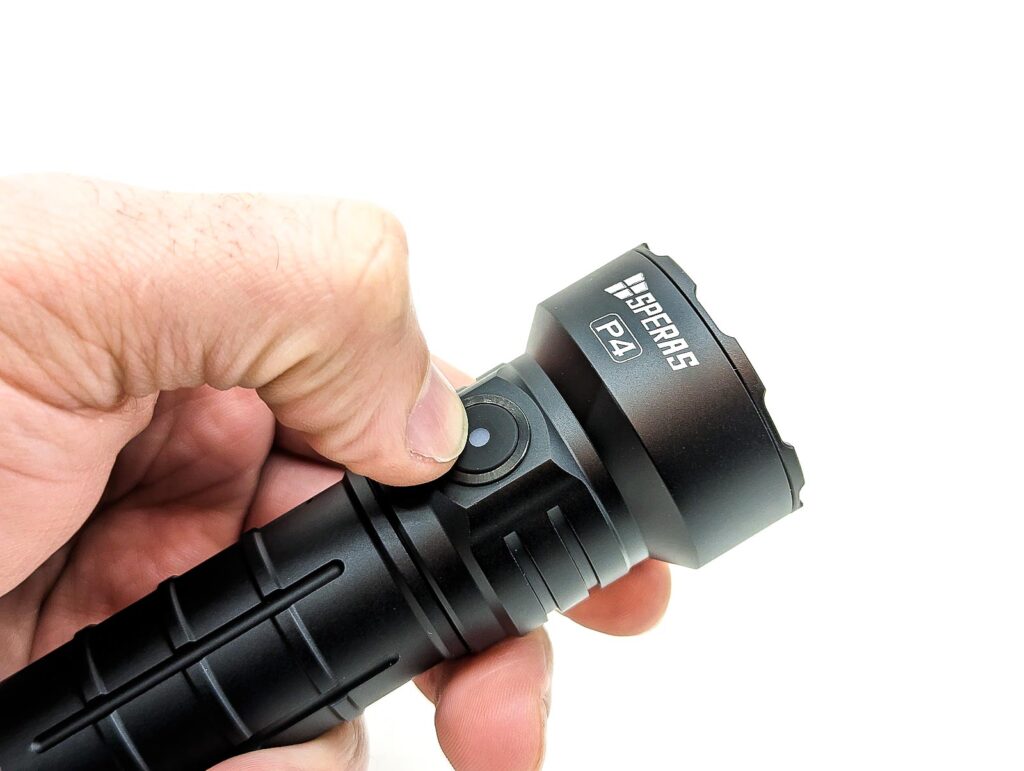
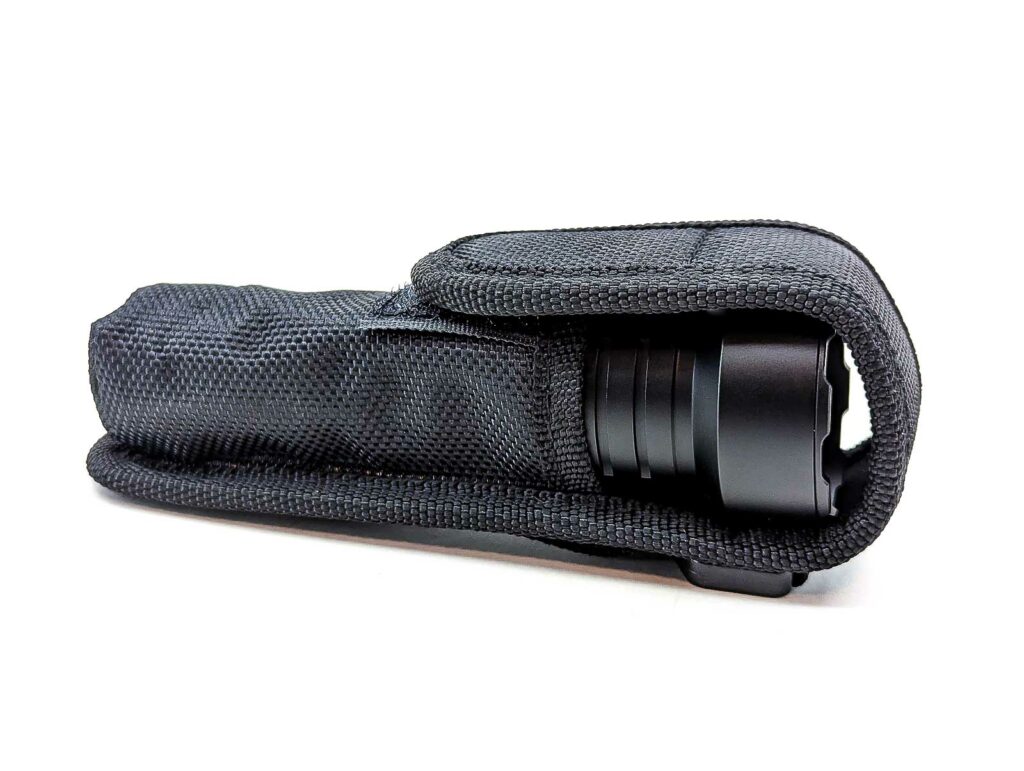
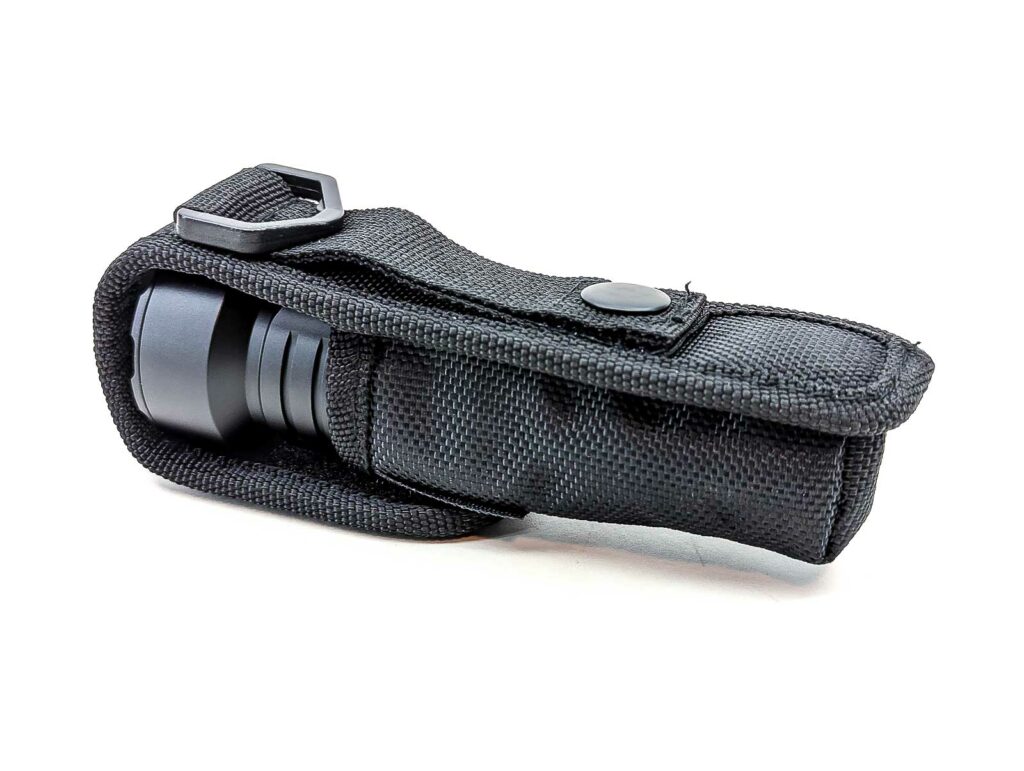
Build Quality and Warranty
Some lights just seems nicer than others. From the moment you pick them up, you can feel it. The anodizing is better (thicker, less glossy). They’ve paid attention to detail on all of the machining, making sure everything lines up perfectly and that there are no sharp edges. And that’s exactly what I’ve found with all of the Speras lights I have reviewed, the P4 included. It just looks and feels like a nice flashlight. As to be expected, it is constructed out of 6061 aluminum alloy with a premium Type III hard-anodized finish.
Warranty:
- The light is covered by a 5 year warranty for “non-artificial” damage
- The warranty does not cover normal wear & tear, modifications, misuse, etc
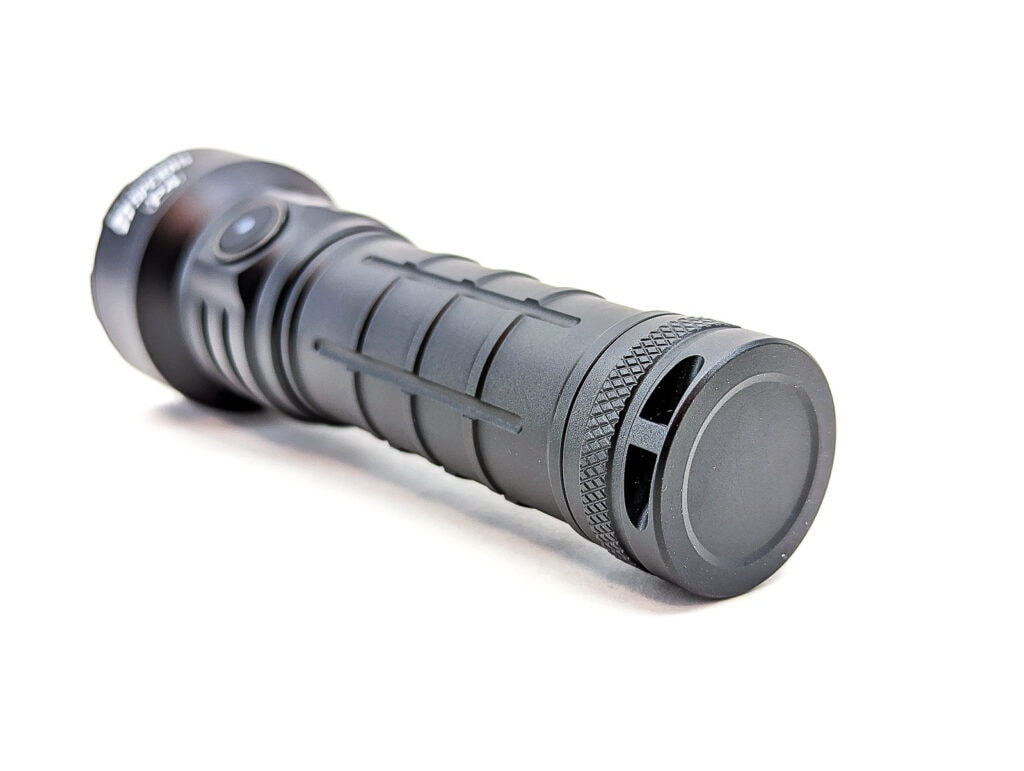
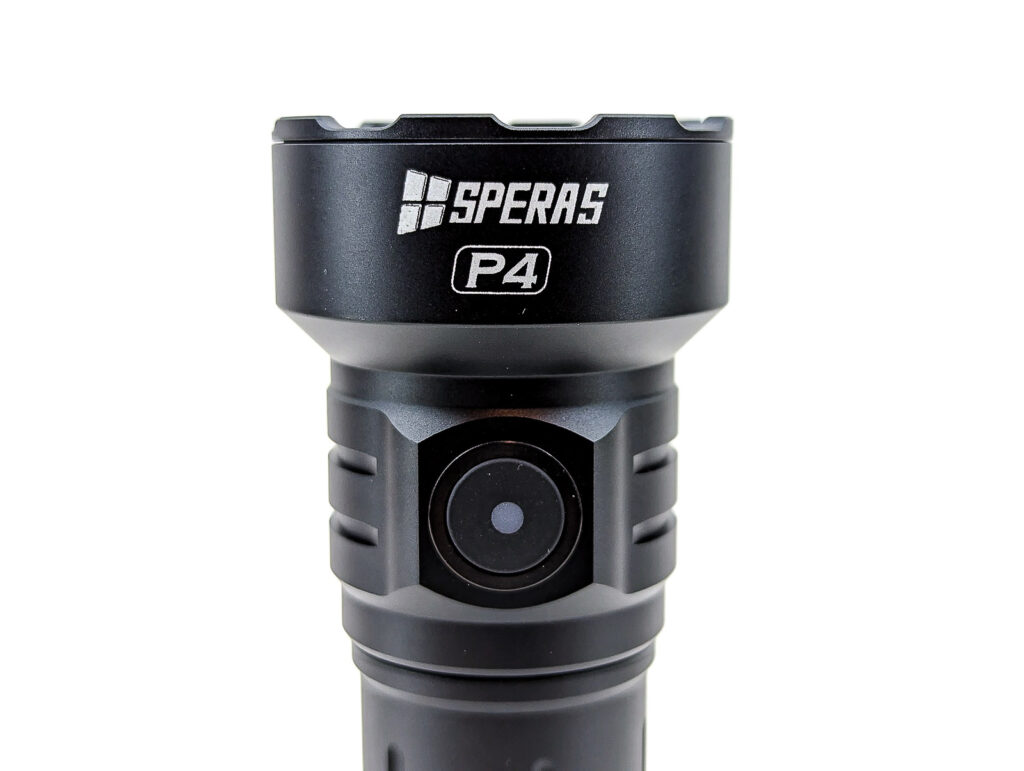
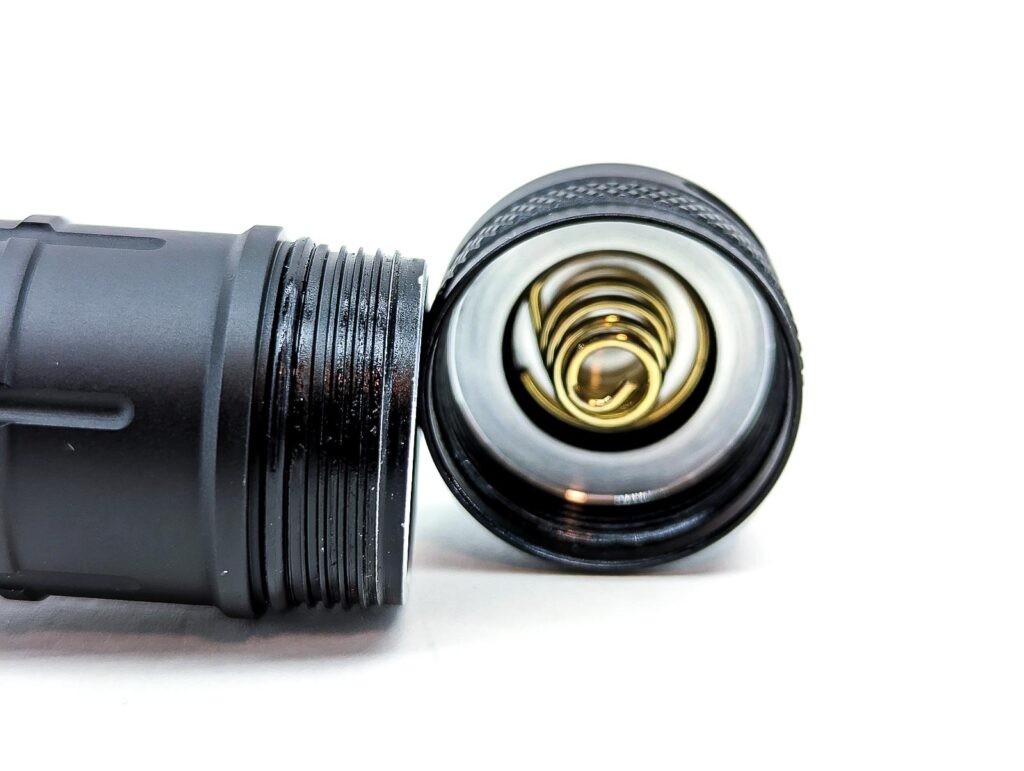
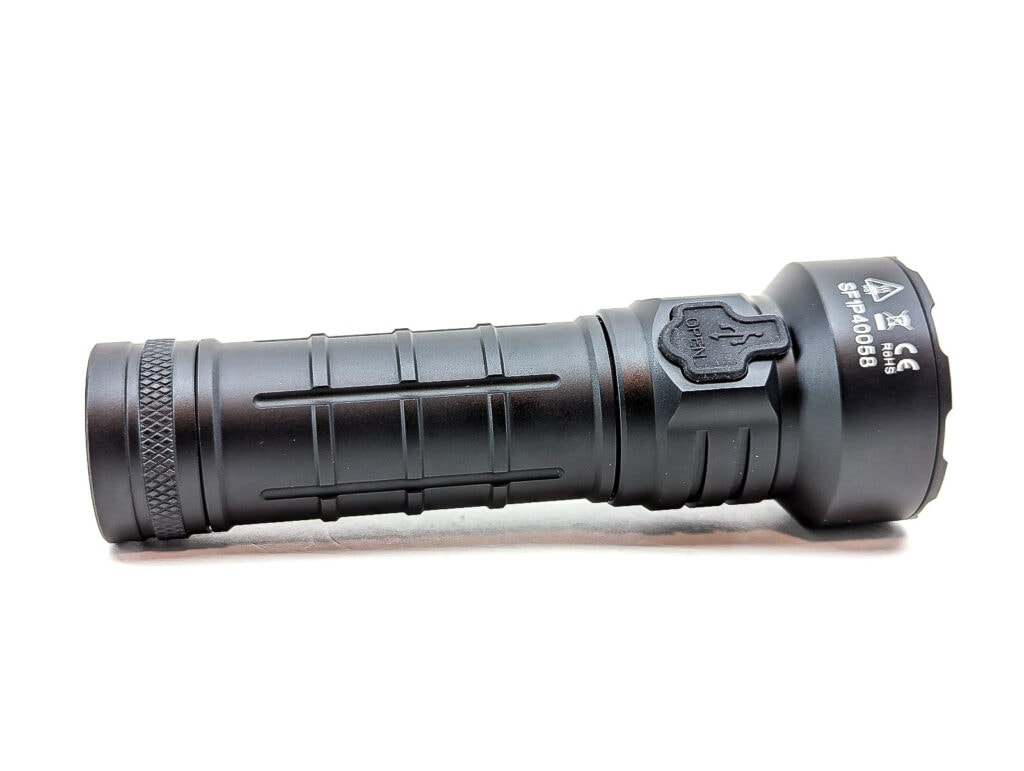
LED, Lens, Bezel, Beam, and Reflector
Unlike the Speras M4 that I reviewed previously, they actually clued us into what LED they chose for the P4 model: an OSRAM P9. It’s one of those run-of-the-mill LEDs that you find in a bunch of lights. It seems to be pretty efficient with a clean beam profile, though it probably won’t win over any aficionados.
The tri-LED reflector is made up of three individual cups with a slight margin in between each one. The OSRAM P9 is centered neatly in the middle of each one using a centering gasket. The reflector is smooth and produces a clean beam without any noticeable artifacts or flower petal shapes. There is some tint shift, but not nearly as bad as what you’d find on a Cree flip-chip design.
Using an Opple Light Master, I obtained the following measurement on Turbo at 5 meters:
- CCT: 6044K
- CRI: 68.7 Ra
- DUV: +0.0064
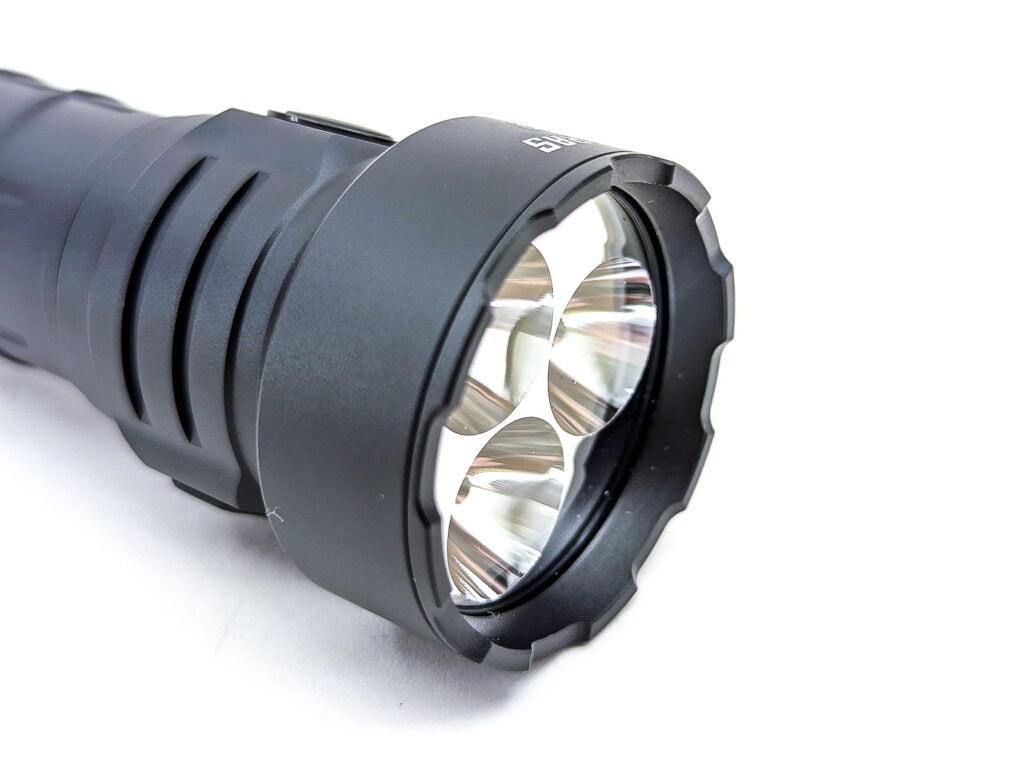

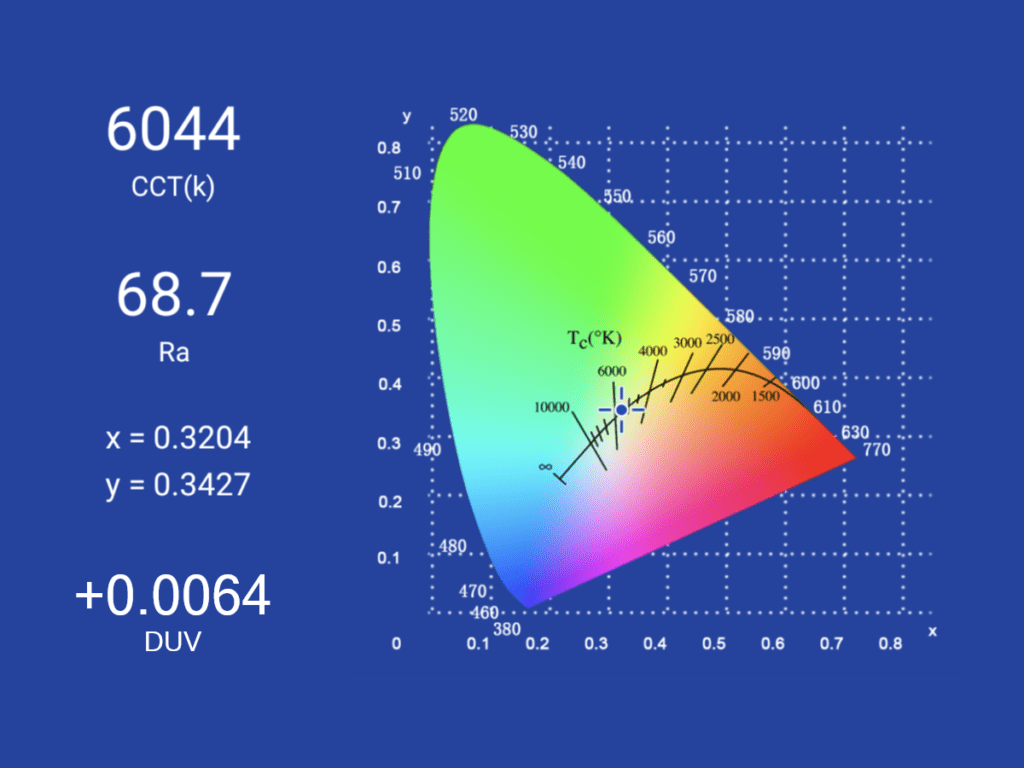
Dimensions and its competition
Dimensions:
| Speras P4 | Millimeters | Inches |
|---|---|---|
| Length | 119 mm | 4.7 in |
| Head diameter | 40 mm | 1.6 in |
| Body diameter | 26.5 mm | 1.0 in |
Dimensions are rounded to the nearest millimeter, and to the nearest tenth of an Inch.
Weight:
| Speras P4 | Weight in grams | Weight in oz |
|---|---|---|
| Without battery: | 112 g | 4.0 oz |
| With battery | 183 g | 6.5 oz |
Weight is rounded to the nearest gram, and to the nearest tenth of an Oz.
Flashlight size comparison with its competition:
Group 1: Speras M4, Speras P4, Speras M2R-35
Group 2: Sofirn IF25A, Speras P4, Nitecore P20iX
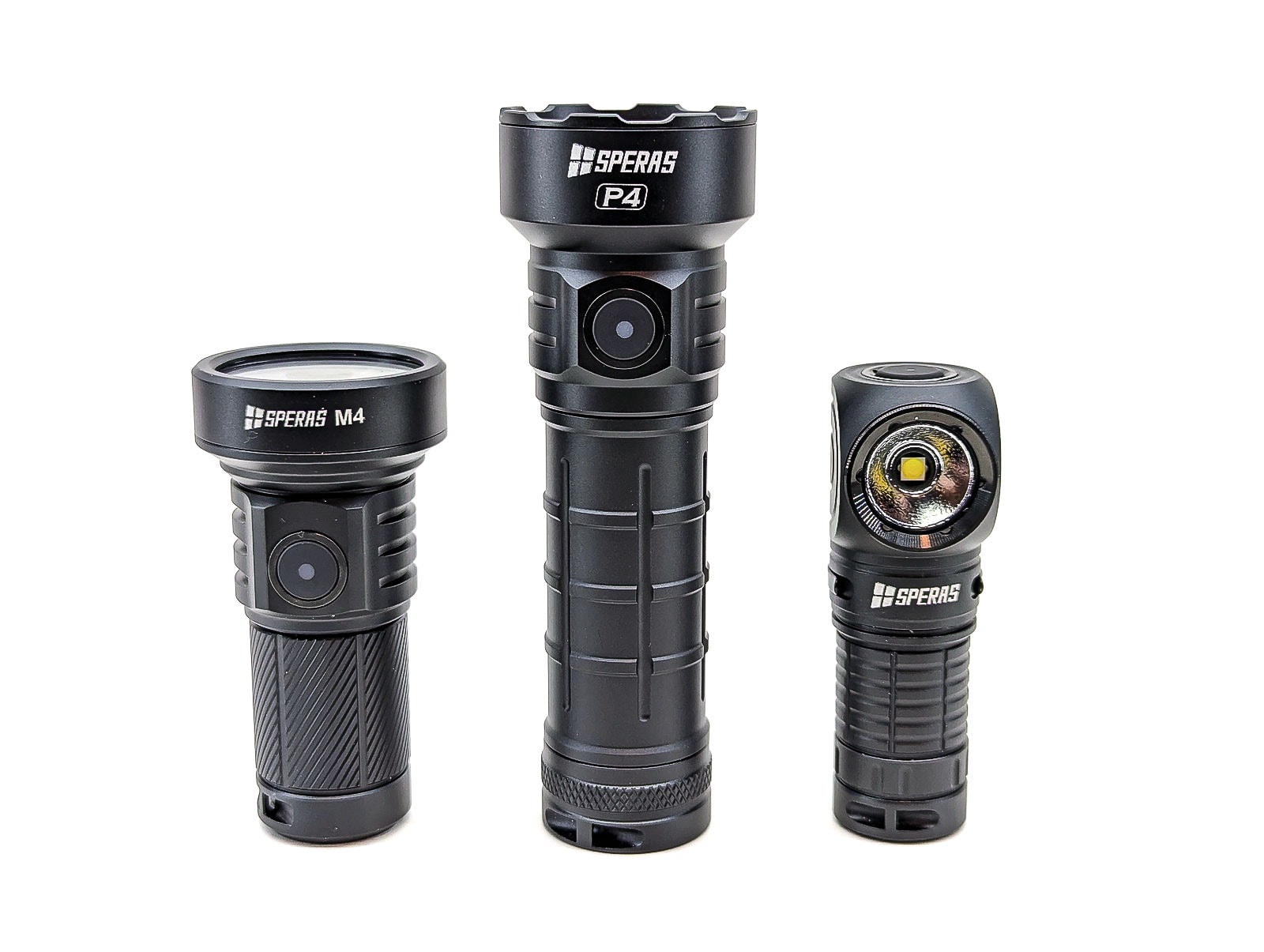

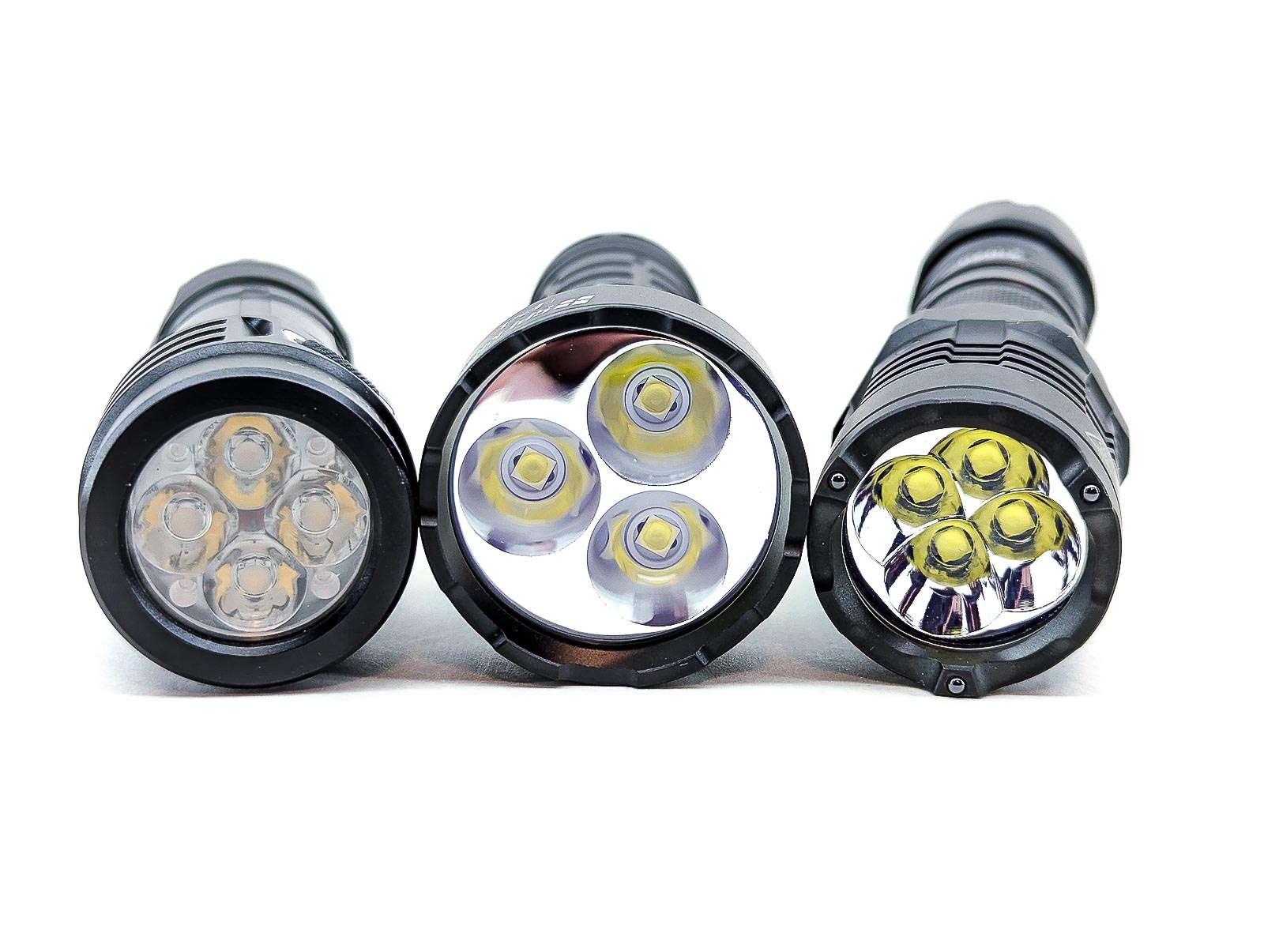
Speras P4 UI: User Interface and Driver
There are some e-switch UI’s that are nearly universal and quick to pick up on. And then there are others that I try to use and I think to myself “oh, why did you have to go and ruin a nice light by giving it a terrible UI?” Thankfully, the Speras P4 belongs to the former camp. The UI is intuitive and natural, and it’s exactly the same as what I saw on the Speras M4.
Available modes: Eco, Low, Medium, High, Turbo
Available blinky modes: Strobe, SOS
User interface:
From OFF:
- Press and Hold: Eco mode
- Single click: turn on (memorized mode)
- Double click: Turbo mode
- 3 clicks: Strobe mode
- Hold 2 seconds: Lockout mode
From ON:
- Press and Hold: change brightness (Low > Medium > High)
- 1 click: turn off
- Double click: Turbo Mode
- 3 clicks: Strobe Mode
Mode memory:
- Yes, it will memorize Low, Medium, and High
Shortcuts:
- To Eco: hold 0.5 seconds from Off
- To Turbo: double click from Off or On
- To Strobe: triple click from Off or On
Low voltage warning:
- When turning the flashlight on, the indicator LED in the switch will light up or 5 seconds to indicate the power level:
- Green: 100% – 70%
- Orange: 70% – 30%
- Red: 30% – 10%
- Red Flash: 10% – 1%
Strobe/blinkies: SOS / Strobe
- Strobe is activated by a triple click from Off or On
- When in Strobe Mode triple-click to get to SOS Mode
Lock-out mode:
- Activate Lockout by a 2 second hold from Off
- Unlock with a triple click
PWM
- There is 31.2 kHz PWM present. So it’s there, but fast enough that you won’t see it with the naked eye
Additional info on the UI:
- Eco mode (and only Eco) can be used while charging
Speras P4 Charging and batteries
The Speras P4 ships with a Speras-branded 5,000 mAh (18.0 Wh) 21700 battery pre-inserted in the light, separated by a little bit of insulating film. The “S50” battery includes a button-top protection circuit, but it seems fairly short for a protected cell. I also tried a Samsung 40T flat-top 21700 battery and it worked just fine, thanks in part to the P4 having a spring at both ends.
Speras says that the built-in USB-C charging supports 5V/2A and should take around 3 hours to give the P4 a full charge. In my testing, it completed in 2 hours and 40 minutes. I observed a 10.1 watt (1.98 amps at 5.08 volts) charge rate. The battery ended up at 4.17 volts.
The Speras P4 ships with a USB-A to USB-C charging cable. It also comes with a little USB OTG adapter (USB-A female to USB-C male) so that you can charge other devices with the P4. Just plug the OTG adapter into the flashlight, then plug the included cord into that. I tried charging a laptop from the Speras P4 and saw a (dis)charge rate of 9.3 watts (1.86 amps at 5.00 volts). This isn’t something I would personally use frequently, but it’s a handy option for emergencies, camping, etc. Just remember to have that OTG adapter with you.

Performance test
Lux was measured by a UNI-T UT383 BT at 5 meters. Lumens were measured in a homemade lumen tube using a VEML7700 sensor, calibrated with a calibration light provided by 1Lumen. The included Speras-branded battery was used for testing.
Lumen measurements (for each mode)
| Mode | Amps at start | Specs | turn on | 30 sec | 10 minutes |
|---|---|---|---|---|---|
| Eco | 30 mA | 15 | 15 lm | 15 lm | – |
| Low | 155 mA | 100 | 91 lm | 90 lm | – |
| Med | 760 mA | 500 | 557 lm | 550 lm | 534 lm |
| High | 3.9 A | 2000 > 600 | 2139 lm | 2044 lm | 649 lm |
| Turbo | 13.4 A | 4000 > 800 | 4999 lm | 4644 lm | 833 lm |
| Turbo at 3.6V | 8.6 | 3760 lm | 3497 lm | – |
Parasitic drain:
- 104 µA
In general, the output either met or exceeded Speras’s output claims.
Battery Life: Runtime graphs
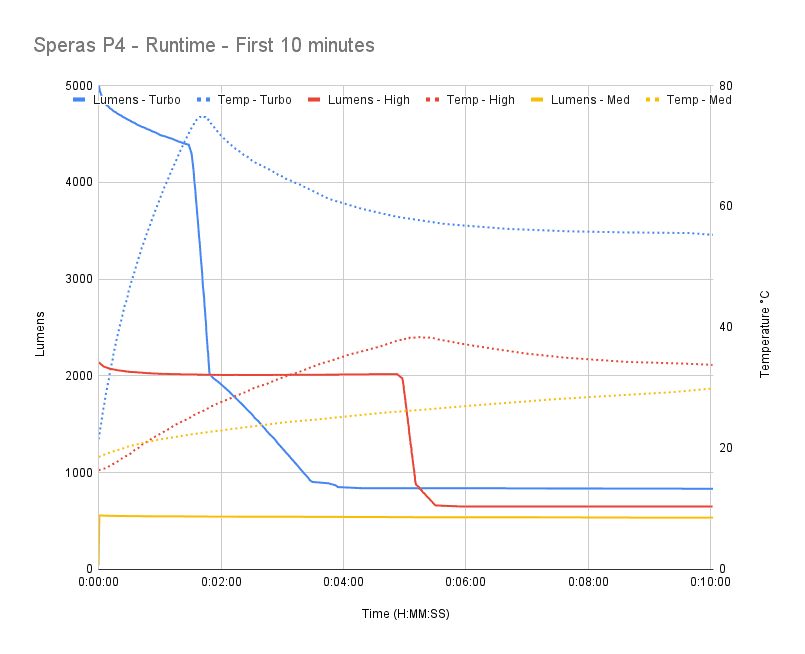
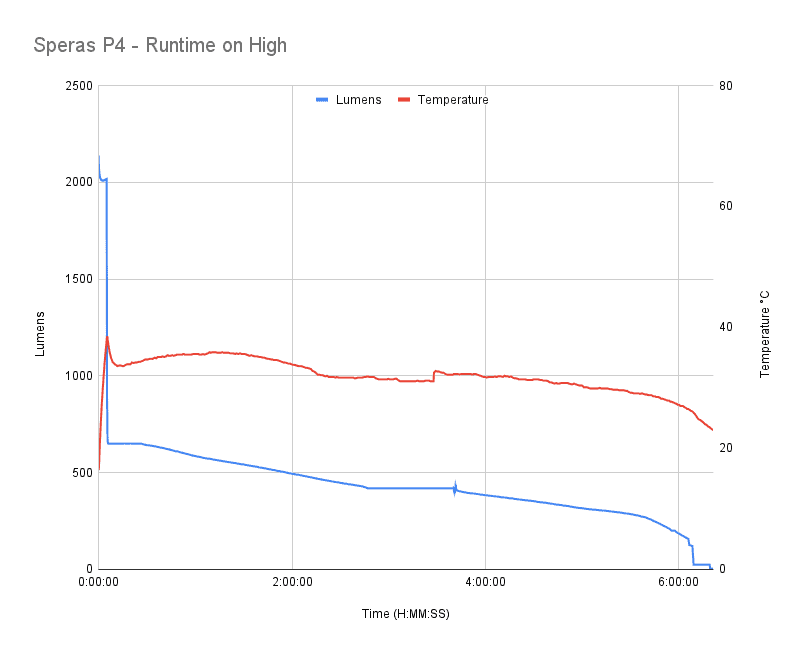
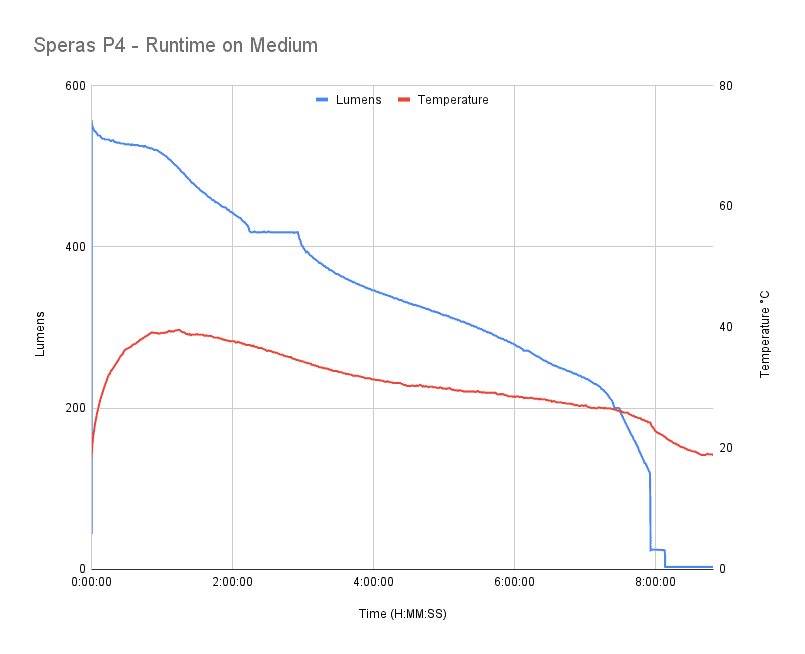
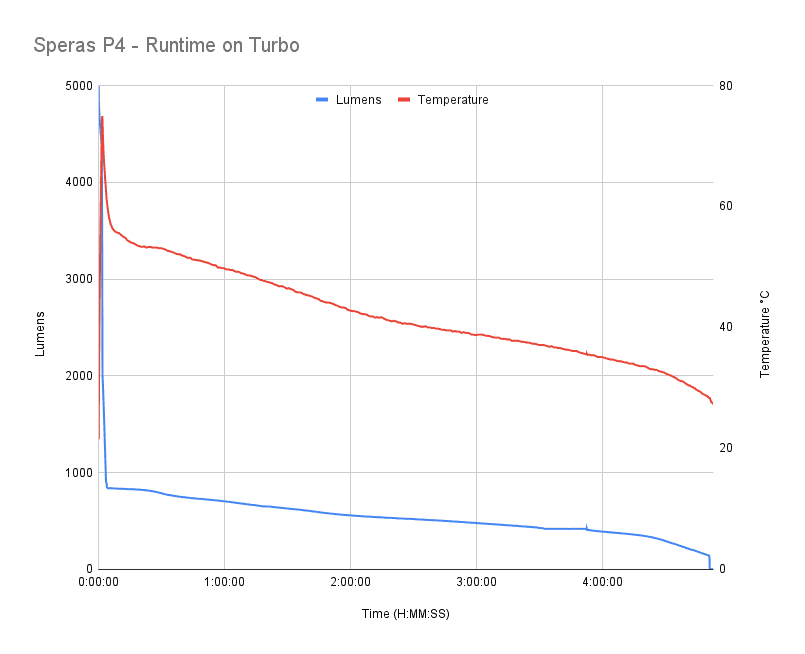
| Mode | Specified | Measured runtime ANSI | Time till shut off |
|---|---|---|---|
| Eco | 167h (6d 23h) | – | – |
| Low | 35h | – | – |
| Med | 8h | 7h 56min | 8h 50min+ |
| High | 90s + 6h | 5h 55min | 6h 21min+ |
| Turbo | 90s + 5h | 3h 9min | 4h 53min+ |
The Speras P4 runtimes seem in-line with specs. The Turbo is a bit off, but that’s because of the large drop in output right around 90 seconds. The other thing to note: at the end of the tests, the P4 kept petering along at 3 lumens for quite a while before eventually shutting off. The timing stopped after the light dropped below 3 lumens for a few minutes.
The runtime tests did reveal something about this light that is my only real dislike about the P4 – the current seems completely unregulated. It appears to be just a PWM’ed MOSFET. This is very common in a lot of lights, especially those in the budget-end of the spectrum. It’s not wrong to PWM a MOSFET, but you do see a constant drop in output as battery voltage falls. And they tend to produce more heat and be a bit less efficient than their switch-mode regulator brethren (buck or boost lights). I would have loved for the Speras P4 to have a nice buck or boost regulator, like both of the other Speras lights I’ve reviewed.
About ANSI FL1 standards: The runtime is measured until the light drops to 10% of its initial output (30 seconds after turning on). This does not mean that the flashlight is not usable anymore. The last column shows how long the light actually works till it shuts off. If there is a + symbol, it means that the test was stopped at that particular point, but the light was actually still running. This happens on certain occasions, with certain drivers, firmware, or batteries.
Peak beam intensity and beam distance measurements
The intensity was measured at 5 meters after being turned on for 30 seconds. Since candela values for Eco and Low are low, those were measured at 2 meters. A UNI-T UT383 BT lux meter was used.
| Mode | Specified | Candela measured | Meters | Yards |
|---|---|---|---|---|
| Eco | 250 cd | 75 | 17 m | 19 yd |
| Low | 800 cd | 540 | 46 m | 51 yd |
| Medium | 2,975 cd | 2,975 | 109 m | 119 yd |
| High | 11,750 cd | 10,450 | 204 m | 224 yd |
| Turbo | 20,750 cd | 24,375 cd | 312 m | 341 yd |
Like the lumen output, the beam intensity tests line up well with Speras’s claims.
About peak beam intensity: Peak beam distance according to ANSI FL1 standards: The calculated value of distance in meters at which the flashlight produces a light intensity of 0.25 lux. (0.25 lux is about the brightness of a full moon shining on an object). The columns ‘Meters’ and ‘Yards’ use rounded numbers.
Beamshots
Camera settings and distance:
Beam shots of the building are taken at 30 m (33 yd) using a Pixel 7 set to ISO 800 with 1/10 second exposure time
Beamshots of the following flashlights compared:
- Speras P4
- ThruNite TC20 Pro
- Nitecore P20iX
- Sofirn SP35

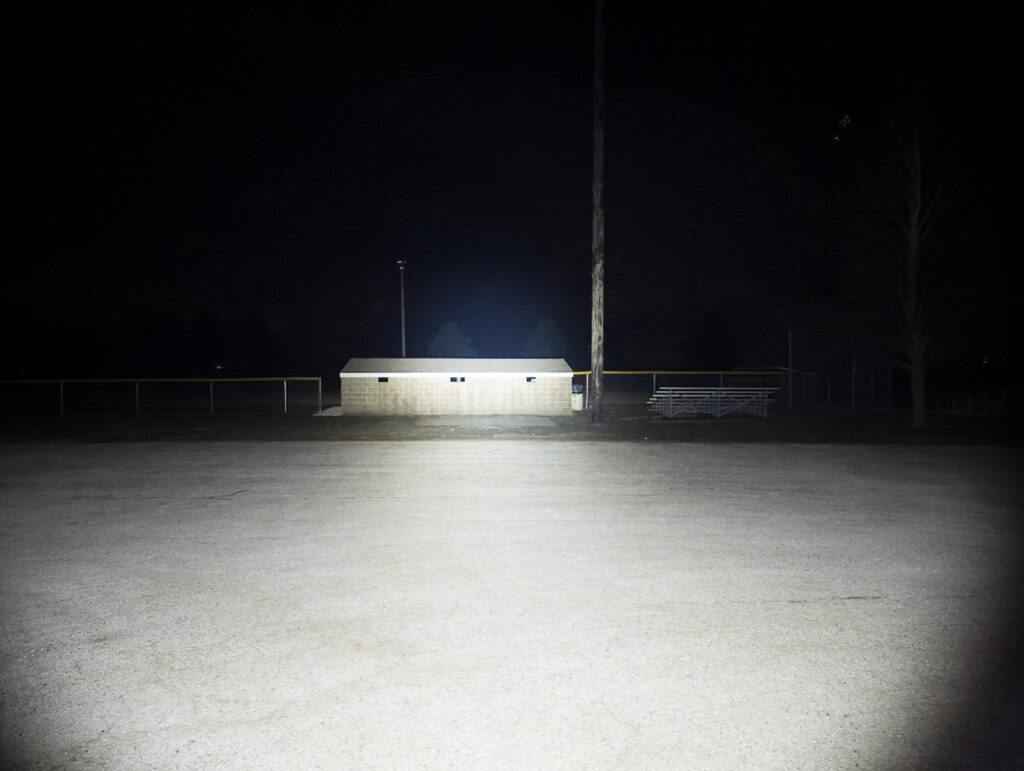

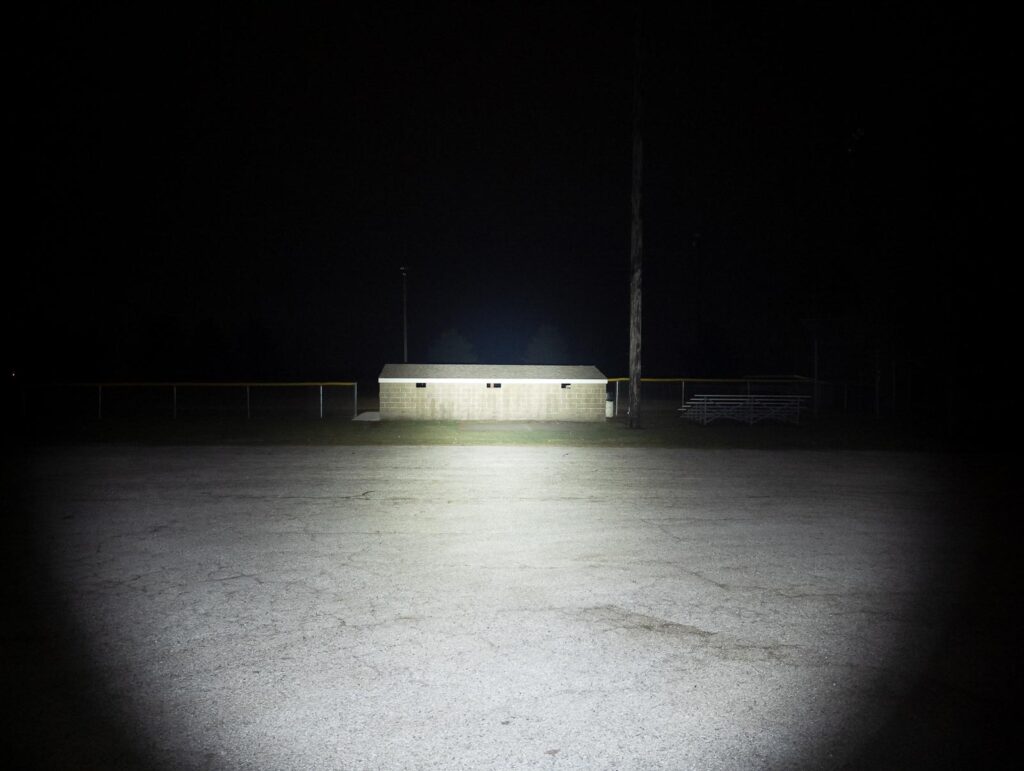
Disclaimer: This flashlight was sent to me for review at no cost by Speras. I have not been paid to review, nor have I been holding back on problems or defects.
Final Verdict
Pros
- Impeccable build quality
- Good looking design
- Nice balance of flood and throw
- Very nice UI
- USB-C charging
- Powerbank functionality
Cons
- Unregulated output
Explanation on star ratings:
1: Avoid: a match would be a better choice – 2: Poor: significant defect or issues; almost unusable – 3: Average: some defects or issues; but still usable 4: Good: recommended (minor issues) – 5: Great: highly recommended

4.5 stars: ★★★★⋆
I came away from the previous Speras reviews (the M4 and M2R-35) really impressed: great build quality, UI, electronics, features, etc. So I was really stoked to try out the compact 4,000 lumen P4 model. And it mostly lived up to my expectations. The build quality still seems top-notch, and the UI is consistent with the M4 (great!). And it does meet specs. What I didn’t really like? Based on the constant drop in output as the battery voltage decreases, it looks like the P4’s driver is just a PWM’ed MOSFET. At this price range, I’d hope to see a buck or boost driver. Overall, though, the Speras P4 still seems to be a high quality flashlight with a lot of lumens.
Buy your Speras P4 here
1lumen selects and reviews products personally. We may earn affiliate commissions through our links, which help support our testing.